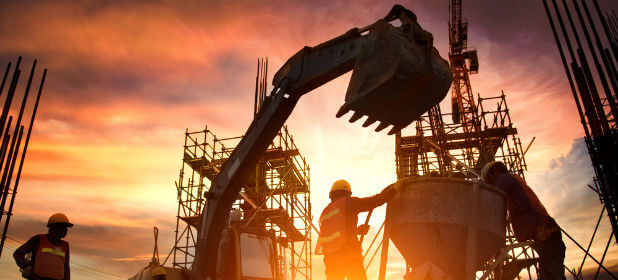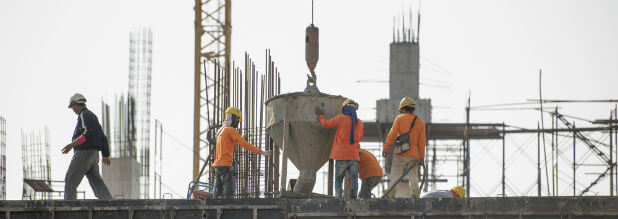Employers and managers are responsible for creating and sustaining a safe work environment for their employees. Therefore, when workers operate or carry out duties around cranes and hoists, they must ensure that employees follow OSHA’s suspended load safety standards.
What Is a Suspended Load?
Loads may be suspended by forklifts, wheel loaders, and overhead, boom, and jib cranes. Essentially, anything that is lifted above ground is considered a suspended load. You’ll find such loads on riggings, slings, pallets, and various pieces of equipment. The larger weight and size of the material lifted, the more hazardous the job and its surrounding areas become.
The Dangers of Working Under a Suspended Load
The most obvious danger is that what goes up usually comes down — and not always how we plan it. Sometimes, the lifted or transported material won’t simply crash with a boom. Even a small overhead load can become lethal.
If a load falls, it can quickly break and split, becoming a series of dangerous and deadly projectiles. As a result, harmful splashes, flooding, shattered bones, and injuries to the eyes, head, and soft tissues can occur. In addition, contact with power lines is possible, potentially leading to life-altering electrical shock.
The third-party safety consultants at Safety by Design understand these dangers, and we know how to assist you. We have decades of experience helping companies reach their full potential while abiding by OSHA standards. Contact us today to discuss your organization’s safety plans.
Safety Rules for Working Under A Suspended Load
It’s common for construction crews to work with and around suspended loads. Workers are often not appropriately trained or fully aware of their particular exposure. Such lack of communication and knowledge leaves much room for carelessness, injury, and even death. Therefore, it’s vital to your business operations that employees remain safe and productive.

OSHA provides specific guidelines for suspended load safety to prevent accidents and injuries when loads are hoisted or suspended during operations. These guidelines are outlined in several standards, primarily under 29 CFR 1926.1431, which deals with cranes and derricks in construction.
Implement this list of OSHA suspended load safety tips for a safer work environment. (And avoid OSHA violations and fines!)
- All employees operating equipment should be adequately trained regarding hoist and overhead crane safety rules and procedures. They should also be certified and licensed to operate said equipment.
- A responsible company employee familiar with the hoist and overhead crane safety tips should test hoisting and crane equipment monthly. In addition, rigging equipment should be tested annually.
- Do not carry loads over people. Equipment can fail unexpectedly, and operator errors can have serious ramifications.
- Parts of the equipment itself, such as empty buckets, forks, and masts, are still considered suspended loads. One does not have to be moving material.
- Further, knowing a suspended load’s stability or swing is essential. The contents might also be susceptible to movement when moving material or equipment.
- We suggest putting a “10-feet rule” in place. It can be dangerous for employees to be within a 10-foot radius of the suspended load, in case of equipment malfunction or an accidental drop. If a load is suspended over 15 feet high, increase that radius.
- If remote controls are available for the equipment you are operating, then that could be a simple solution to maintaining a safe zone for operators.
- Check the load rating for straps, slings, and chains. Be sure they can bear the load of the forklift, crane, or bucket. Remember to always limit the load based on the lowest rating of the lifting system. If unclear at all, cease all operations until certain!
- Conduct safety inspections before using hoists, cranes, slings, and other machine components. In addition, they must adhere to the company’s set preventative maintenance and manufacturer’s requirements.
- All buckets, forks, and slings should rest on the ground when not in use, even if they contain or carry no load.
OSHA standard 1910.179(n)(3)(vi) states that “The employer shall require that the operator avoid carrying loads over people.” As noted in an OSHA Standard interpretation, (all load-handling fixtures are considered part of the load (even if they carry nothing themselves). Also, take into consideration 1910.179(n)(3)(x), “The employer shall ensure that the operator does not leave his position at the controls while the load is suspended,” while understanding that a load can mean any attached load-handling fixture and the load would be considered not in use if there is no operator at the controls.
- Avoid “shock loading.” Do not suddenly activate the lift controls by issuing excessive force on the load. Instead, be cautious, applying power easily. Do not jerk the controls; accelerate and decelerate slowly.
- Don’t raise the load more than is necessary.
- Multiple employees should never be in charge of operating a single piece of equipment. Operator hand signals should only be given to warn of hazards.
- At times, surroundings can grow noisy, or a voice may simply not be heard over distance. Establish hand signals, and teach these to all company employees.
- Equipment operators should watch their load the entire time it is in motion, from liftoff to landing.
- No person should ever be permitted to ride in a tractor bucket or on the load itself.
- Always check for load balance, and clear a pathway before movement.
- Take weather conditions into consideration before moving a load.
- Loads that can potentially shift during movement must be secured in place.
- Be careful that the load does not shift outside the equipment’s tires or tracks. The equipment may tip over.
- Check that all alarms and horns are in working order.
- Maintain a distance of 10 feet from power lines.

FAQs on OSHA Suspended Load Safety
- What should I do if a suspended load begins to swing uncontrollably?
- If a load starts swinging, clear the area immediately and alert the operator. Operators should avoid sudden movements and gradually stabilize the load.
- Are there specific weight limits for suspended loads under OSHA guidelines?
- Yes, OSHA requires that lifting equipment never exceed its rated load capacity. Always check the load rating on slings, chains, and straps before lifting.
- What is considered a “safe zone” around a suspended load?
- A common guideline is maintaining a 10-foot radius from the suspended load. For loads suspended above 15 feet, expand that radius accordingly.
- What steps should I take if a load drops or equipment fails during lifting?
- Immediately secure the area, ensure all employees are accounted for, and follow your company’s emergency response plan. Report the incident to your supervisor and initiate an inspection before resuming operations.
- Are warning alarms required on all lifting equipment?
- OSHA requires working warning devices such as horns or alarms to alert employees when equipment is in motion or if there’s an emergency.
- Can weather conditions impact suspended load safety?
- Absolutely. High winds, rain, and icy conditions can reduce visibility, affect load stability, and increase the risk of equipment failure.
Contact Safety by Design for Suspended Load Safety Advice
When working under a suspended load, OSHA requires specific standards to be met. For the best OSHA training in Houston, contact Safety by Design. We offer training and consulting services, and our team of professionals specializes in OSHA facilitation and data tracking. You might even find the organization and safety management system software you’re looking for in our SafeTeam Web Application (which you may try for free now!)
Contact our team today to learn how we can make your workplace safer and more productive!
| Thank you for visiting our website! We appreciate your interest in workplace safety. Please note that Safety by Design is not affiliated with OSHA. However, we can assist you with the following OSHA-related services: ✔ OSHA Mock Inspection ✔ OSHA Training ✔ Facilitate OSHA Inspections and Citations If you need to file a complaint with OSHA, please call 800-321-6742 (OSHA) or visit this page for other methods to contact them. |




